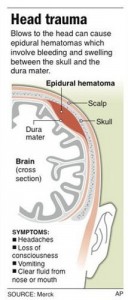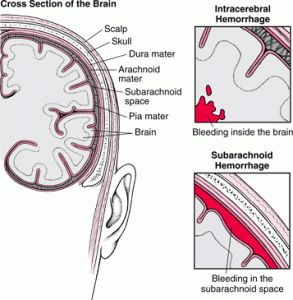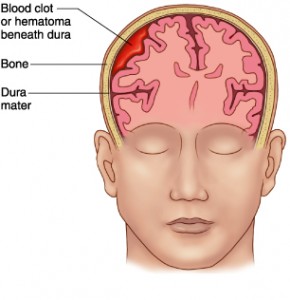The Final Stroke for Gary Coleman
Posted by Dr B on 5/28/10 • Categorized as Entertainment,Neurological and Stroke
 As we reported yesterday, Different Strokes actor Gary Coleman was in critical condition after a head injury. This morning it was reported that he had suffered a brain hemorrhage as a result of that fall and that he was on life-support. Word now is that the 42 year old actor has died. According to Coleman’s manager, John Alcantar, “He had a brain hemorrhage and he was lucid but he went unconscious [Thursday] afternoon.”
As we reported yesterday, Different Strokes actor Gary Coleman was in critical condition after a head injury. This morning it was reported that he had suffered a brain hemorrhage as a result of that fall and that he was on life-support. Word now is that the 42 year old actor has died. According to Coleman’s manager, John Alcantar, “He had a brain hemorrhage and he was lucid but he went unconscious [Thursday] afternoon.”
Brain hemorrhage is a non-specific term which simply means “bleeding into the brain”. It does not tell us the cause or the location of the blood. Trauma is the most common cause in individuals under 50, however other causes include high blood pressure, brain aneurysms, blood or bleeding disorders, or even brain tumors. The bleeding can occur in the brain tissue itself (intracerebral hemorrhage) or in the various spaces around the brain (subarachnoid, epidural, subdural).
 Epidural hematomas are caused by a blow to the side of the head. The skull bone that covers the major artery (middle meningeal artery) to the brain surface is relatively weak and prone to injury. Patients may initially be asymptomatic or have a brief loss of consciousness. After a so-called “lucid period,” when bleeding inside the brain starts to expand, patients will complain of headache, and with continued expansion, loss of consciousness or other abnormalities. Treatment is surgical with removal of the blood clot and repair of the artery.
Epidural hematomas are caused by a blow to the side of the head. The skull bone that covers the major artery (middle meningeal artery) to the brain surface is relatively weak and prone to injury. Patients may initially be asymptomatic or have a brief loss of consciousness. After a so-called “lucid period,” when bleeding inside the brain starts to expand, patients will complain of headache, and with continued expansion, loss of consciousness or other abnormalities. Treatment is surgical with removal of the blood clot and repair of the artery.
This was the diagnosis in the case of actress Natasha Richardson, who died of an epidural hemorrhage after a skiing accident. With the history of head injury, a “lucid period”, followed by a downward turn into unconsciousness and death, one could speculate that Gary Coleman may have had an epidural hemorrhage. Tests done at the hospital may have confirmed this, however a specific diagnosis for Mr. Coleman has not yet been released.
 A sub-arachnoid hemorrhage is bleeding that occurs into the sub-arachnoid space between the arachnoid and pia mater. In general, head trauma is the most common cause. Spontaneous (primary) subarachnoid hemorrhage usually results from ruptured aneurysms. It is the cause in about 85% of patients. Other causes include bleeding from an arteriovenous malformation (AVM), bleeding disorder, use of blood thinners, or unknown causes (idiopathic).
A sub-arachnoid hemorrhage is bleeding that occurs into the sub-arachnoid space between the arachnoid and pia mater. In general, head trauma is the most common cause. Spontaneous (primary) subarachnoid hemorrhage usually results from ruptured aneurysms. It is the cause in about 85% of patients. Other causes include bleeding from an arteriovenous malformation (AVM), bleeding disorder, use of blood thinners, or unknown causes (idiopathic).
While non-traumatic subarachnoid hemorrhage is typically associated with the sudden onset of a severe headache, traumatic subarachnoid hemorrhage occurs in the setting of a moderate or severe head trauma. These patients often have other injuries which complicate their presentation and they can present anywhere from relatively asymptomatic to comatose.
Singer Bret Michaels is a recent case of non-traumatic subarachnoid hemorrhage about whom we have written several stories.
 A subdural hemorrhage is caused by bleeding that takes place due to the rupture of one or more of the blood vessels (typically veins) that travel through the subdural space, located between the dura mater, which adheres to the skull, and the arachnoid mater enveloping the brain. Acute bleeds develop after high speed acceleration or deceleration injuries. Acute subdural hematomas are among the deadliest of all head injuries. The bleeding fills the brain area very rapidly, compressing brain tissue. Symptoms are similar to those of anyone having a stroke:
A subdural hemorrhage is caused by bleeding that takes place due to the rupture of one or more of the blood vessels (typically veins) that travel through the subdural space, located between the dura mater, which adheres to the skull, and the arachnoid mater enveloping the brain. Acute bleeds develop after high speed acceleration or deceleration injuries. Acute subdural hematomas are among the deadliest of all head injuries. The bleeding fills the brain area very rapidly, compressing brain tissue. Symptoms are similar to those of anyone having a stroke:
- Confused speech
- Difficulty with balance or walking
- Headache
- Lethargy or confusion
- Loss of consciousness
- Nausea and vomiting
- Numbness
- Seizures
- Slurred speech
- Visusal disturbances
- Weakness
For more information:
 |
Resounding Health(tm) Traumatic brain injury |
![]()

